THINK ABOUT YOUR LAST abs workout. It was probably sit-ups, Russian twists, reverse crunches, with rep counts reaching the hundreds. Those are perfectly good moves. But we propose a different way, via a practice that goes back a hundred years. Pilates workouts stand out thanks to the 360-degree approach to core stability. The focus isn’t solely on strengthening the front of the body, or the rectus abdominis (six-pack abs). It’s also on deep core muscles, or transverse abdominis. Moves hit the obliques that stack up your sides and the muscles that fold around your back, too.
And if you’re a winter sports lover, spending weekends skiing, snowboarding, snowshoeing, and cycling, Pilates has particular utility, for both body and mind.
“In outdoor pursuits, you need to stay focused, breathe, and pay attention to what’s in front of you,” says Michael Gayle of MGayle Outdoor Adventures.
Years ago, Gayle, an adventure guide in Buffalo, Minnesota, began practicing Pilates, and it helped him level up his backcountry game. Pilates focuses on the core muscles responsible for doing things like holding a ski position for minutes at a time, and stabilizing on an icy bike trail. And it works hip flexors and glutes, which get used when you’re tramping around in the snow. Today he’s a certified Pilates instructor, and he designed the workout here with the outdoor athlete in mind.
The 10 Best Workout Classes for Men
And there’s the mental part. “Due to Pilates training, I have enhanced levels of stability, mobility, and mindfulness,” Gayle says. “It even serves as a wellness barometer, balancing my extreme adventure side.”
A note on the pace—it’s intentionally slow. Pilates requires a person to maintain core engagement, alignment, and body awareness, which translates into improved biomechanics and less wear and tear on the body while out in the wild.
When doing the routine, focus on breathing, which will help core activation. Inhale through the nose until you feel pressure on the rib cage. Exhale forcefully through pursed lips, like blowing through a straw, until all air is released. Call on this breath work when fatigue creeps in and the core starts to lose rigidity.
The equipment is simple: a mat, resistance band, and two yoga blocks. (If you can find a sun-filled studio—like the one at Performance Lab by the Wright Fit in New York City, shown here—even better.) Pilates may not require huge weights, but when done right, your abs will be quivering by the end.
The Kettlebell Ski Swing Will Transform Your Core and Upper Body
Pilates Primer
If these moves pique your interest, think about trying a studio class. Here’s some background before you go.
What is Pilates, exactly?
It’s a collection of exercises to develop functional balance, strength, and flexibility. The moves are performed on a mat or on a reformer, a large wood platform with a sliding carriage, springs, ropes, and handholds.
Who does it?
These days, everyone. LeBron James and Aaron Judge do Pilates for strength, control, and focus. It’s also used in rehab. In fact, Joseph Pilates got the idea when he was an orderly during WWI, caring for injured soldiers.
What does the science say?
Researchers have studied whether it helps with chronic low back pain, since it bolsters the transverse abdominis muscles. A study in the British Journal of Sports Medicine finds doing Pilates twice a week may help.
The Secret to Mark Wahlberg’s Forever-Shredded Physique
The Workout
For a full workout, do 6 to 8 reps of each move—the slower the better, focusing on control. Rest 30 seconds to 1 minute between exercises, and do 3 rounds. As you progress, drop to 4 to 6 reps of each move, but cut out the rest time. If you’re training for a specific activity, do the moves listed every day at least two weeks before a big outing.
Expert Tips
Pilates practice relies heavily on breathing patterns. But you also need to maximize each breath. Holding on to tension constricts the chest, reducing lung capacity. If you begin breathing shallowly, take a moment to get centered and let go of any anxiety. Pilates is a quiet practice that will have your muscles screaming. If you settle in and hold these poses, you’ll reap rewards, such as strong abs, shoulders, glutes—and mind.
These Battle Ropes Workouts Give You Endless Ways to Slam, Wave, and Whip Your Body Into Shape
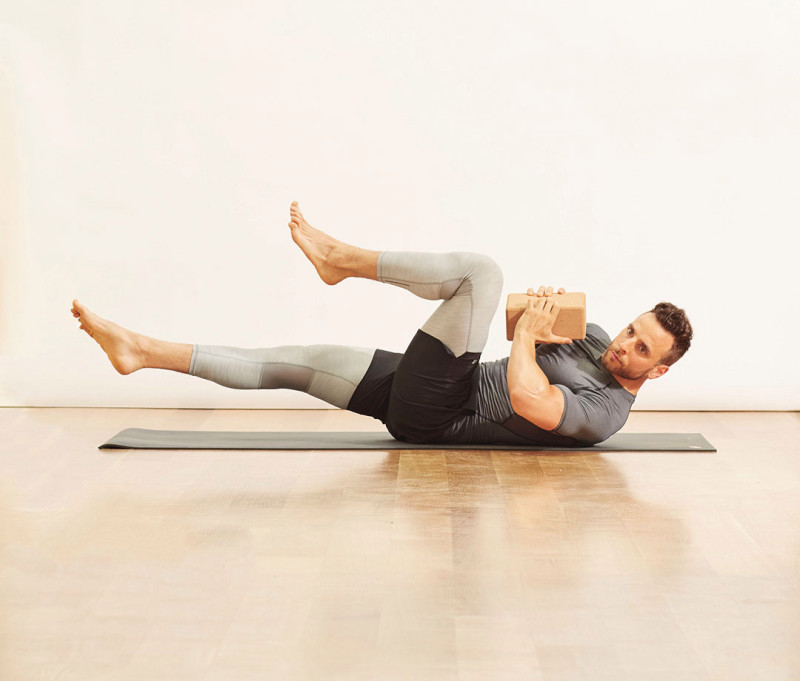
Injuries on the mountain are often related to fatigue, especially late in the day, when your glutes are pooped and legs feel like jelly. These moves help “teach” your core to move and support the legs to overcome tiredness, while also improving balance and agility.
Crisscross
Lie on floor with legs raised, knees bent 90 degrees, shins parallel to the floor. Hold a yoga block at your chest with both hands, elbows flared, to start. Inhale, then exhale and extend right leg while you lift right shoulder and rotate toward left knee. Inhale to return to starting position, then repeat on right side for 1 rep.
Justin Steele for Men's Journal
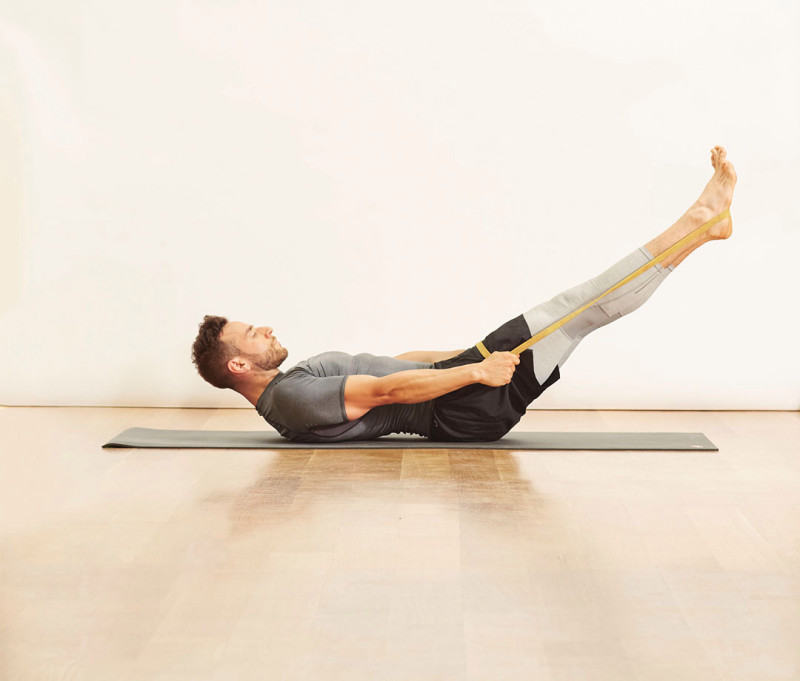
Lie on floor with legs raised, knees bent 90 degrees, shins parallel to floor, a resistance band behind arches of feet and holding other ends, arms along torso. Exhale, lift shoulders off floor, press rib cage into mat, and extend legs to start. Inhale for 5 pulses, while performing small beats with arms, initiating from shoulders. Continue with an exhale for 5 pulses. Repeat for 10 reps or 100 pulses.
Justin Steele for Men's Journal
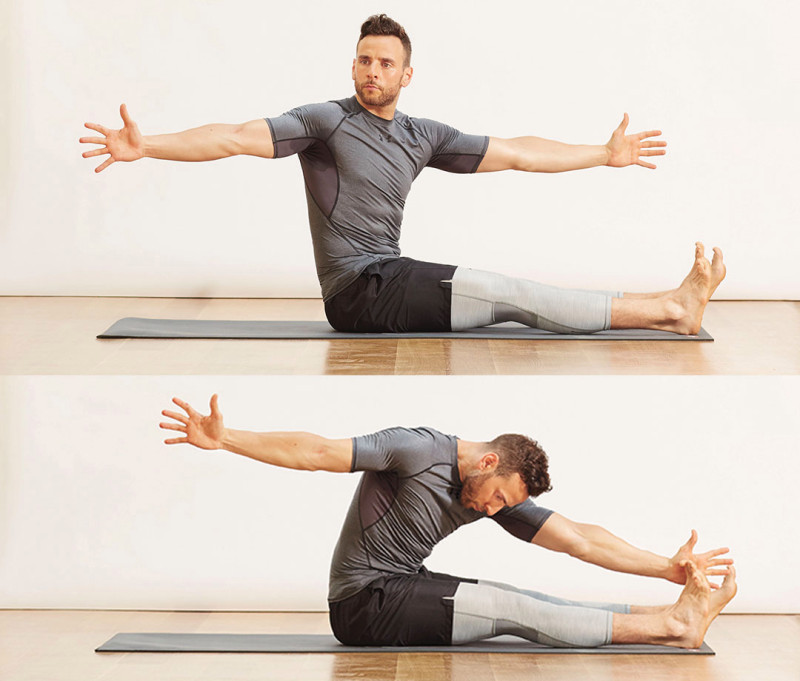
Flexibility and power is the name of the game when it comes to hoofing it in the outdoors. But—forgive us for stating the obvious—when you’re doing it in the cold, across snowy and slippery expanses, it’s a different beast. Muscles are less elastic in the cold. These moves will increase your baseline flexibility, which helps avoid strains and pulled muscles in the field.
Saw
Sit on floor, legs extended, heels wider than hips, arms extended to sides, and palms facing forward, to start. Inhale and rotate torso clockwise, then exhale, fold forward, and reach left palm to left foot. Inhale and reverse rotation, then exhale and return to start. Repeat on right side for 1 rep.
Justin Steele for Men's Journal
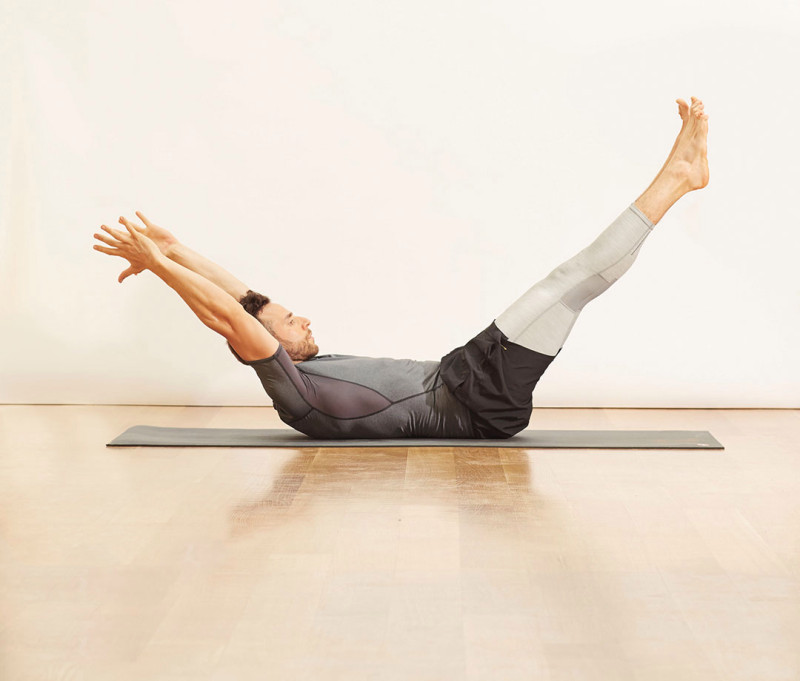
Lie on floor, then raise head, neck, and shoulders; raise legs, bending knees at 90 degrees, shins parallel to the floor to start. Inhale and point fingertips toward heels, then exhale, extend legs so they are at a 45-degree angle to the floor, and reach fingertips behind head. Inhale to return to the start for 1 rep.
Justin Steele for Men's Journal
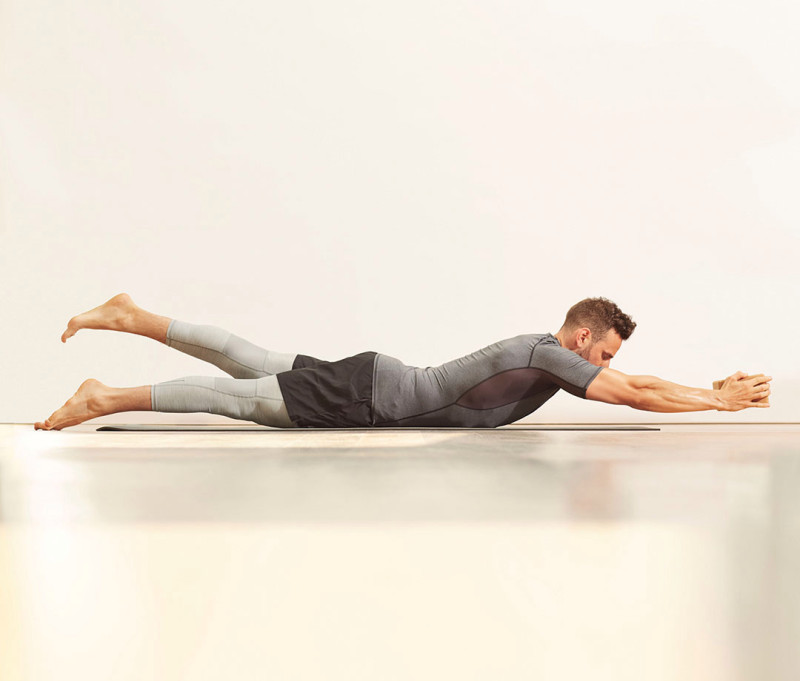
Lie on stomach, with legs, torso, and arms farming a straight line, holding a yoga block horizontally. Inhale, then exhale and lift chest, arms, and legs off floor to start. Inhale while lifting and lowering legs, like a swimmer’s kick, for 5 pulses. Exhale and repeat sequence—20 pulses total—for 1 rep. Inhale, then exhale and lower entire body to the mat.
Justin Steele for Men's Journal
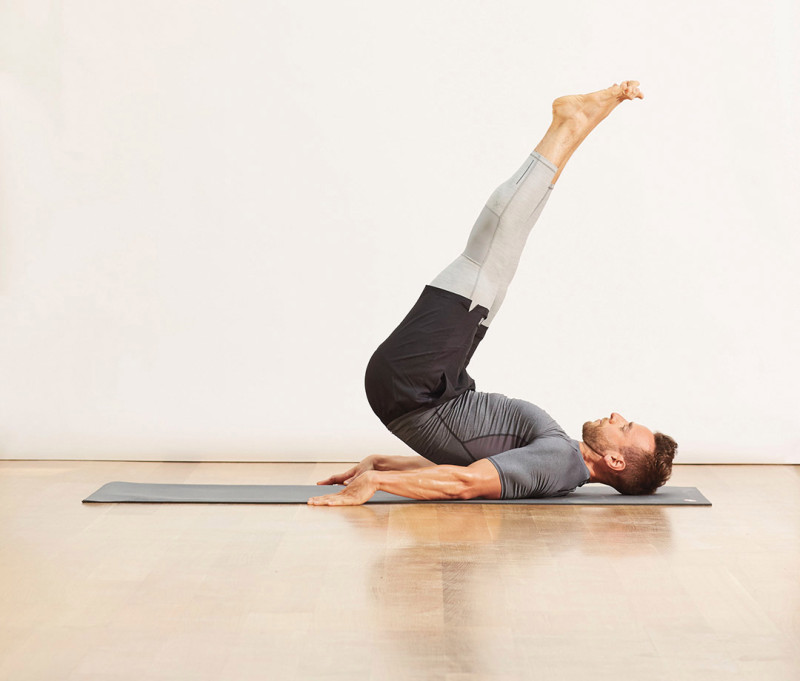
Power generation is the name of the game. Yes, you absolutely have to do due diligence with lifting, and working on explosive power and balance. These Pilates moves magnify all that hard work by training your arms and torso to work together and support the legs. It’s the sort of power that comes in handy when you’re in attack position.
Corkscrew
Lie on back, arms along sides, legs straight at a 45-degree angle to floor to start. Inhale, bring legs toward torso and roll spine off mat into a hover position—hips are off the ground and tipped back, feet are overhead. Exhale, press through hands and tilt legs to left as you roll down the spine through center at a 45-degree angle. Tilt legs to right and roll back up to hover to complete a circle. Repeat in opposite direction for 1 rep.
Justin Steele for Men's Journal
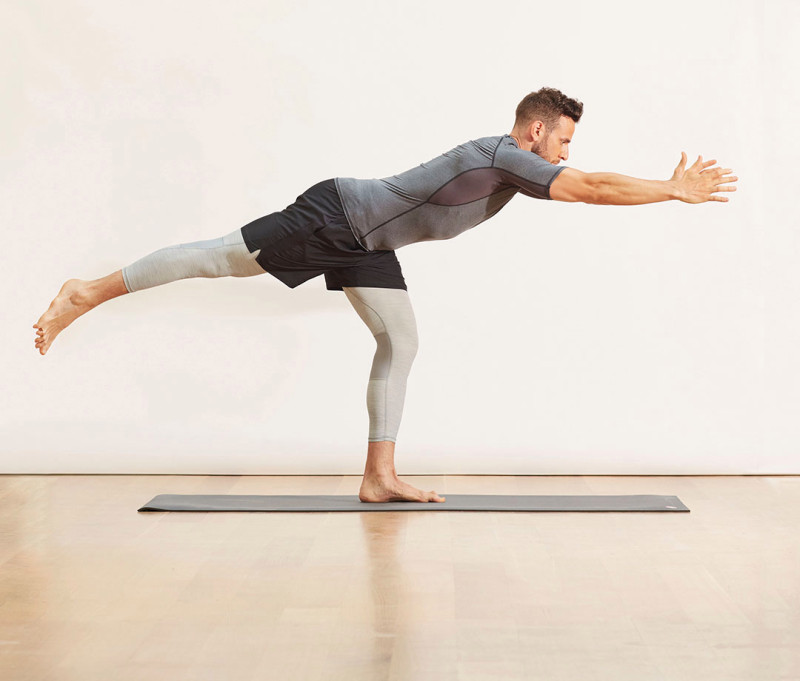
Stand, feet hip-width apart, to start. Shift weight left, inhale, lift right knee to chest, elbows down at sides, palms facing up near chest. Exhale, soften left knee, hinge forward, and extend arms, and right leg back. Reverse to start, then repeat on right side for 1 rep.
Justin Steele for Men's Journal
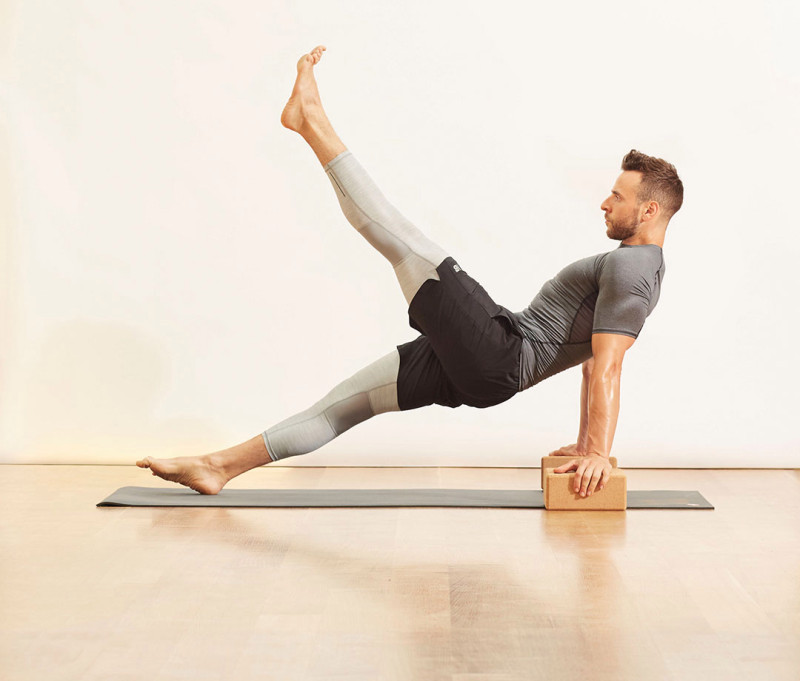
Sit, legs extended, hands just behind shoulders and resting on yoga blocks, to start. Lift into a reverse plank. Point toes and slightly flex upper spine, chin tilted toward chest. Exhale and lift left leg, flexing hip as much as possible without pelvis or spine moving. Hold, then inhale, flexing foot and lowering leg to start. Switch sides for 1 rep.
Justin Steele for Men's Journal
The post These Core-Crushing Pilates Workouts Will Level Up Your Winter Sports Game appeared first on Men's Journal.
Comments are closed.